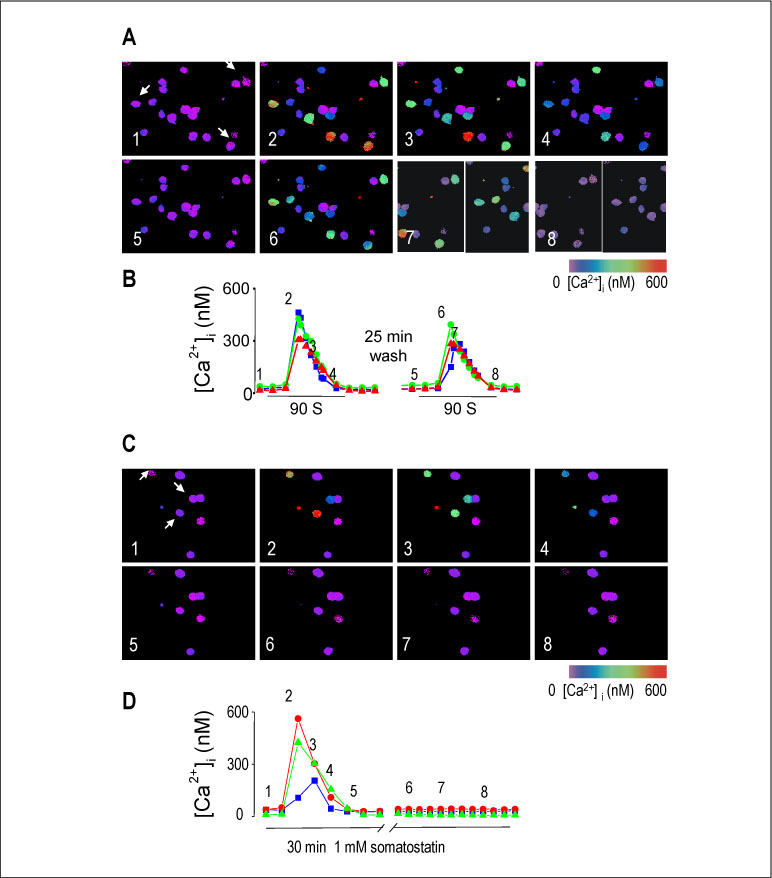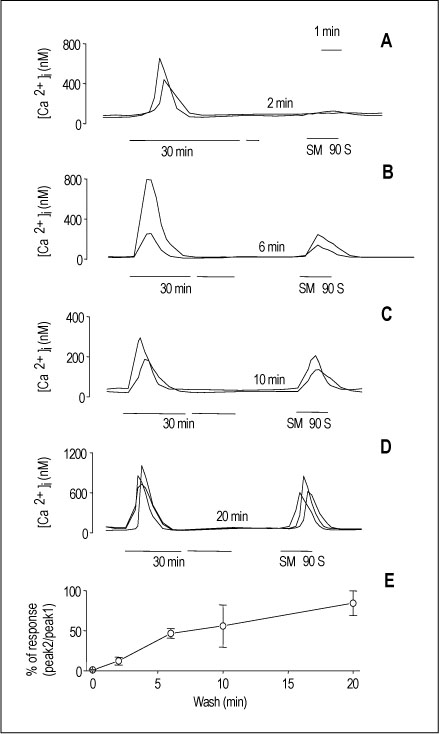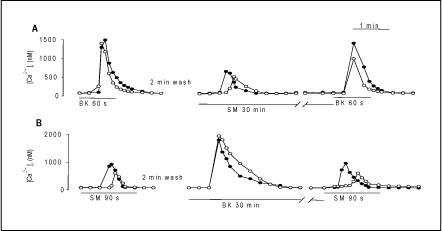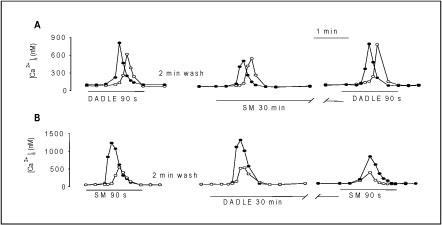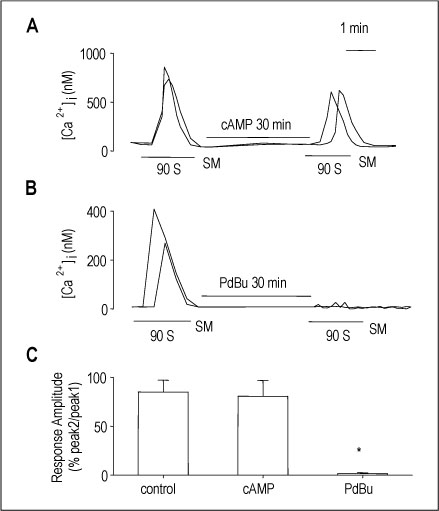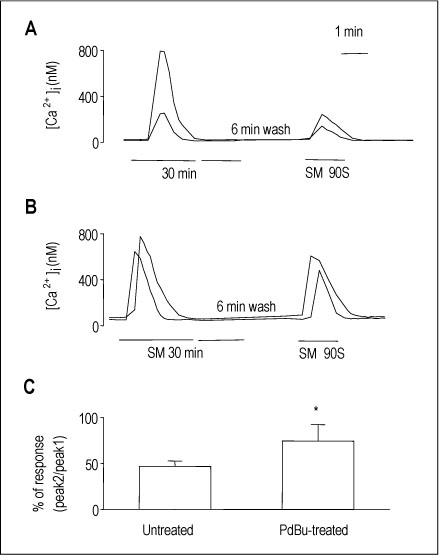J Korean Soc Endocrinol.
2005 Aug;20(4):353-361. 10.3803/jkes.2005.20.4.353.
Role of Protein kinase C in Desensitization of Somatostatin-induced Calcium Signalling in NG108-15 Cells
- Affiliations
-
- 1Department of Internal Medicine and Department of Physiology, College of Medicine, The Catholic University of Korea, Seoul, Korea.
- KMID: 2100466
- DOI: http://doi.org/10.3803/jkes.2005.20.4.353
Abstract
-
BACKGROUND: Activation of G-protein coupled-somatostatin receptors induces the release of calcium from inositol 1, 4, 5-trisphosphate-sensitive intracelluar stores. G-protein-coupled receptor signaling decreases with prolonged exposure to an agonist.
SEBJECTS and METHODS: Fura-2-based digital Ca2+ imaging was used to study the effects of prolonged exposure to an agonist on the somatostatin-induced intracellular Ca2+ concentration([Ca2+]i) increases in NG108-15 cells, which were differentiated with CO2-independent medium and 10micrometer forskolin.
RESULTS
Exposure to somatostatin(1micrometer) for 30 min completely desensitized the NG108-15 cells to a second somatostatin-induced response. The cells recovered gradually over 20 min following washout of the somatostatin. The desensitization was not due to depletion of the intracellular Ca2+ stores, and pretreatment for 30 min with bradykinin(100nM), which activates phospholipase C, or DADLE(D-Ala2-D-Leu5 enkephalin, 1microM), which activates phospholipase C, failed to cross-desensitize the somatostatin-evoked [Ca2+]i increases. Treatment with 8-cpt-cAMP(0.1mM) for 30min did not influence the somatostatin-induced[Ca2+]i increases. Phorbol 12, 13-dibutyrate(PdBu, 1microM) blocked the response completely. Down-regulation of PKC due to 24 h exposure of PdBu (1microM) inhibited the somatostatin-induced desensitization.
CONCLUSION
Prolonged exposure of somatostatin to NG108-15 cells desensitized the somatostatin-induced release of Ca2+ from the intracelluar store, with protein kinase C also involved in the desensitization.
MeSH Terms
Figure
Reference
-
1. Hagen PM. Somatostatin receptor expression in clinical immunology. Metabolism. 1996. 45:86–87.2. Schindler M, Humphrey PPA, Emson PC. Somatostatin receptors in the central nervous system. Prog Neurobiol. 1996. 50:9–47.3. Schonbrunn A, Gu A-Z, Dournard P, Beaudet A, Tannenbaum GS, Brown PJ. Somatostatin receptor subtypes: specific expression and signaling properties. Metabolism. 1996. 45:8–11.4. Hoyer D, Bell GI, Berelowitz M, Epelbaum J, Feniuk W, Humphrey PP, O'Carroll AM, Patel YC, Schonbrunn A, Taylor JE, Reisine T. Classification and nomenclature of somatostatin receptors. Trends Pharmacol Sci. 1995. 16:86–88.5. Yasuda K, Rens-Dominano S, Breder CD, Law SF, Saper CB, Reisine T, Bell GI. Cloning of a novel SRIF receptor, SSTR3, that is coupled to adenylyl cyclase. J Biol Chem. 1992. 267:20422–20428.6. Vanetti M, Vogt G, Holt V. The isoforms of the mouse somatostatin receptor (MSSTR2A and MSSTR2B) differ in coupling efficiency to adenylate- cyclase in agonist-induced receptor desensitization. FEBS Lett. 1993. 331:260–266.7. Liapakis G, Tallent M, Reisine T. Molecular and functional properties of somatostatin receptor subtypes. Metabolism. 1996. 45:12–13.8. Beaumont V, Hepworth MB, Luty JS, Kelly E, Henderson G. Somatostatin receptor desensitization in NG108-15 cells. J Biol Chem. 1998. 273:33174–33183.9. Jin W, Lee NM, Loh HH, Thayer SA. Opioids mobilize calcium from inositol 1,4,5-trisphosphate-sensitive stores in NG108-15 cells. J Neurosci. 1994. 14:1920–1929.10. Smart D, Lambert DG. δ-opioids stimulate inositol 1,4,5-trisphosphate formation, and so mobilize Ca2+ from intracelluar stores, in undifferented NG108-15 cells. J Neurochem. 1996. 66:1462–1467.11. Akbar M, Okajima F, Tomura H, Majid MA, Yamada Y, Seino S, Kondo Y. Phospholipase C activation and Ca2+ mobilization by cloned human somatostatin receptor subtypes 1-5, in transfected COS-7 cells. FEBS Lett. 1994. 348:192–196.12. Kubota A, Yamada Y, Kagimoto S, Yasuda K, Someya Y, Ihara Y, Okamoto Y, Kozasa T, Seino S, Seino Y. Multiple effector coupling of somatostatin receptor subtype SSTR1. Biochem Biophys Res Comm. 1994. 204:176–186.13. Tomura H, Okajima F, Akbar M, Abdulmajid M, Sho K, Kondo Y. Transfected human somatostatin receptor type 2, SSTR2, not only inhibits adenylate cyclase but also stimulates phospholipase C and Ca2+ mobilization. Biochem Biophys Res Comm. 1994. 200:986–992.14. Rhie D-J, Sung JH, Ha US, Ha U-S, Kim HJ, Min DS, Hahn SJ, Kim MS, Jo YH, Yoon SH. Somatostatin mobilizes calcium from inositol 1,4,5-trisphosphate-sensitive stores in NG108-15 cells. Brain Res. 2003. 975:120–128.15. Freedman NJ, Lefkowitz RJ. Desensitization of G protein-coupled receptors. Rec Prog Hormone Res. 1996. 51:319–335.16. Grynkiewicz G, Peonie M, Tsien RY. A new generation of calcium indicators with greatly improved fluorescence properties. J Biol Chem. 1985. 260:3440–3450.17. Yoon SH, Lo T-M, Loh HH, Thayer SA. δ-opioid-induced liberation of Gβγ mobilizes Ca2+ stores in NG108-15 cells. Mol Pharmacol. 1999. 56:902–908.18. Nishizuka Y. Protein kinases in signal transduction. Trends Biochem Sci. 1984. 163–169.19. Lohse MJ. Molecular mechanisms of membrane receptor desensitization. Biochim Biophys Acta. 1993. 1179:171–188.20. Yoon SH, Jin WZ, Spencer RJ, Loh HH, Thayer SA. Desensitization of δ-opioid-induced mobilization of Ca2+ stores in NG108-15 cells. Brain Res. 1998. 802:9–18.21. Lo T-M, Thayer SA. Refilling the inositol 1,4,5-trisphosphate-sensitive store in neuroblastoma X glioma hybrid NG108-15 cells. Am J Physiol: Cell Physiol. 1993. 33:C641–C653.
- Full Text Links
- Actions
-
Cited
- CITED
-
- Close
- Share
- Similar articles
-
- Role of Calmodulin in the Generation of Reactive Oxygen Species and Apoptosis Induced by Tamoxifen in HepG2 Human Hepatoma Cells
- The Effect of Activation of Protein Kinase C on the Calcium-dependent K; Current in Rat Basilar Smooth Muscle Cells
- The Effect of Protein Kinase C Pretreatment on Gliotoxin Induced Apoptosis in H9c2 Cells
- A role of endogenous somatostatin in exocrine secretion induced by intrapancreatic cholinergic activation
- Regulation of Protein Kinase in KCl-induced Contraction of Cat Gastric Smooth Muscle

